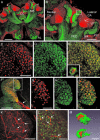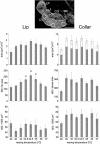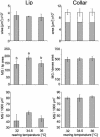Synaptic organization in the adult honey bee brain is influenced by brood-temperature control during pupal development
- PMID: 15024125
- PMCID: PMC384730
- DOI: 10.1073/pnas.0400773101
Synaptic organization in the adult honey bee brain is influenced by brood-temperature control during pupal development
Abstract
Recent studies have shown that the behavioral performance of adult honey bees is influenced by the temperature experienced during pupal development. Here we explore whether there are temperature-mediated effects on the brain. We raised pupae at different constant temperatures between 29 and 37 degrees C and performed neuroanatomical analyses of the adult brains. Analyses focused on sensory-input regions in the mushroom bodies, brain areas associated with higher-order processing such as learning and memory. Distinct synaptic complexes [microglomeruli (MG)] within the mushroom body calyces were visualized by using fluorophore-conjugated phalloidin and an antibody to synapsin. The numbers of MG were different in bees that had been raised at different temperatures, and these differences persisted after the first week of adult life. In the olfactory-input region (lip), MG numbers were highest in bees raised at the temperature normally maintained in brood cells (34.5 degrees C) and significantly decreased in bees raised at 1 degrees C below and above this norm. Interestingly, in the neighboring visual-input region (collar), MG numbers were less affected by temperature. We conclude that thermoregulatory control of brood rearing can generate area- and modality-specific effects on synaptic neuropils in the adult brain. We propose that resulting differences in the synaptic circuitry may affect neuronal plasticity and may underlie temperature-mediated effects on multimodal communication and learning.
Figures




References
-
- Himmer, A. (1927) Z. Vgl. Physiol. 5, 375-389.
-
- Seeley, T. D. (1985) Honeybee Ecology: A Study of Adaptation in Social Life (Princeton Univ. Press, Princeton).
-
- Heinrich, B. (1993) The Hot-Blood Insects: Strategies and Mechanisms of Thermoregulation (Springer, Berlin).
-
- Kleinhenz, M., Bujok, B., Fuchs, S. & Tautz, J. (2003) J. Exp. Biol. 206, 4217-4231. - PubMed
-
- Koeniger, N. (1978) Apidologie 9, 305-320.
Publication types
MeSH terms
LinkOut - more resources
Full Text Sources

